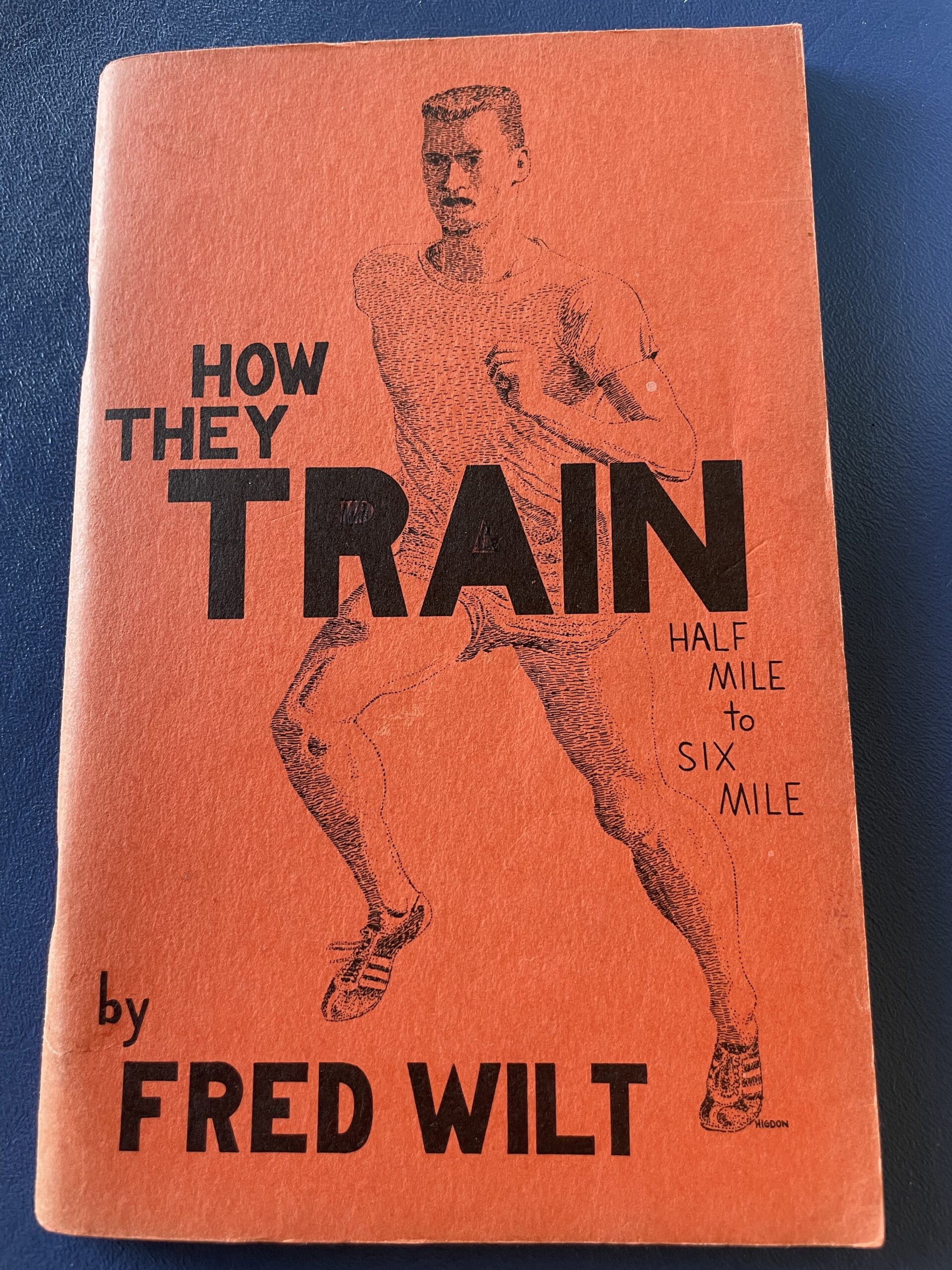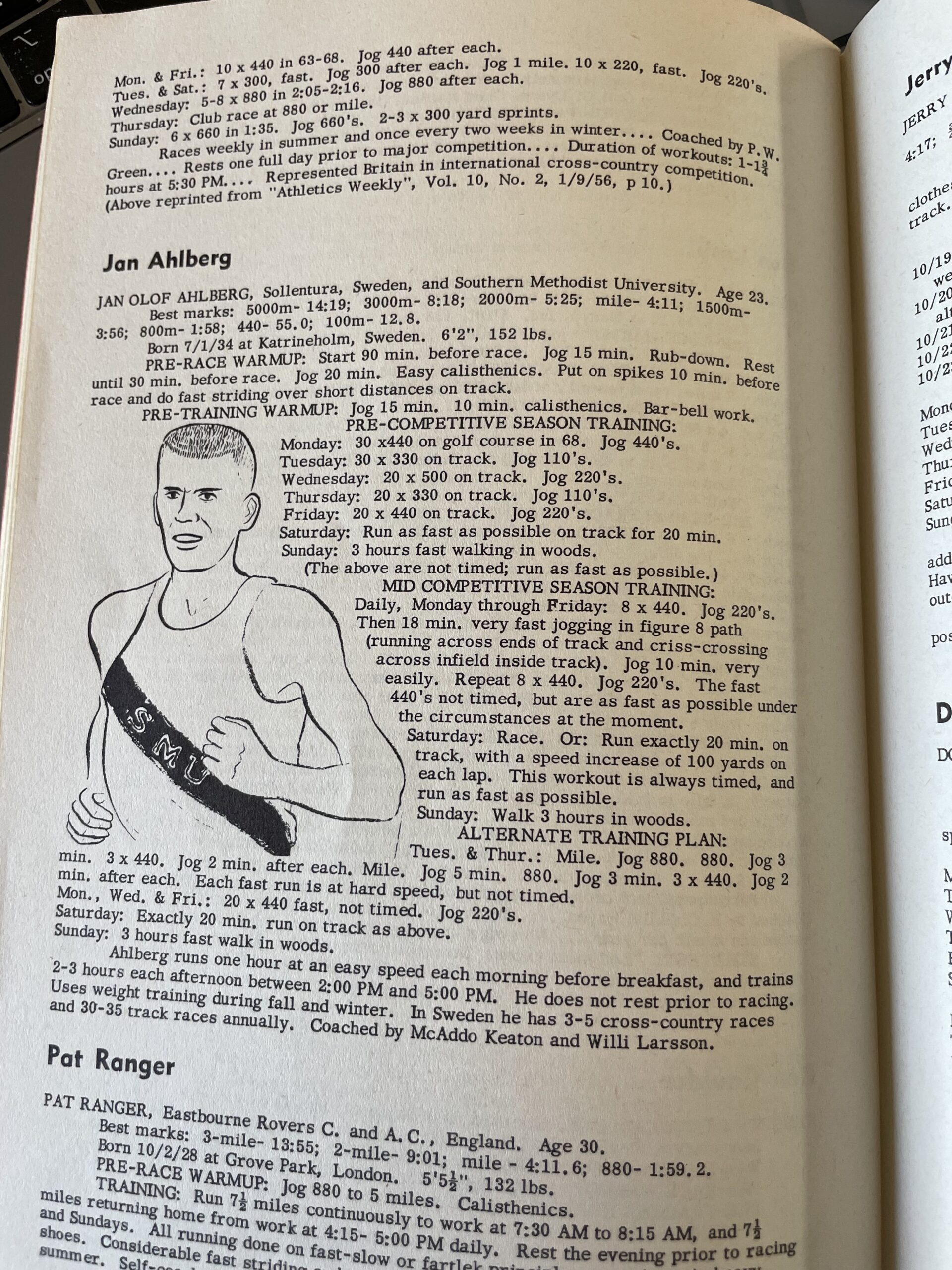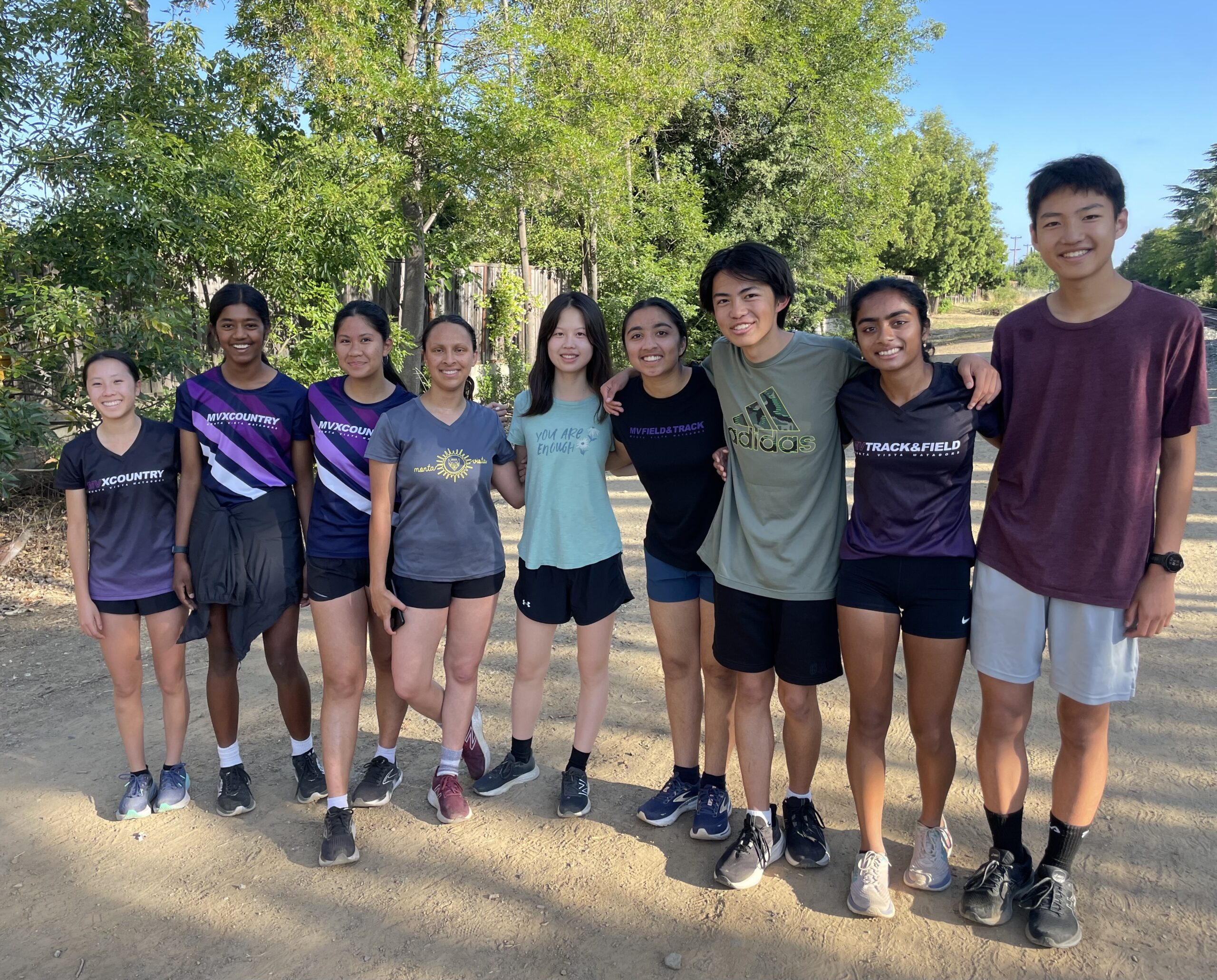
I was cleaning out a drawer and found this hilarious old book, “How They Train.” What the author did was talk to hundreds of runners, ask them what workouts they ran, and write up the results. This was what coaches and athletes had before there was a lot of scientific information about running available. All we could do is talk to other people and see what they did.
Here is an example from the book:

In pre-season, 30x4oo!?!! 16×400 (plus more) Monday through Friday! Holy smokes. This book had some gems. I bet you are happy that I am not pulling workouts out of this coaching manual. The more I look at Jan Ahlberg’s training plan, the crazier it looks! Yikes.
The world of distance running and cross-country racing has evolved significantly since the publication of “How They Train” in 1959. The methods described in this book are a far cry from what we practice today.
“How They Train” was a lot of anecdotal advice; the runner or coach would tell you, “This is what I ran, and I got these results.” The problem is, if you follow their example and do not get the same results–then what? It might be great advice, but maybe it is not complete–what did the person giving the advice eat? Was he at a different altitude? What was their running background and base mileage? What about cross-training? Later on, other coaches* started applying a lot more science to distance running, allowing for a more systematic evolution of training methods.
I thought about how the science around running evolved as I walked on the beach this week. While the science of running evolved, so did the science of positive psychology. My studies in positive psychology at the University of Pennsylvania last year taught me a scientific approach to guiding people toward happy, fulfilling, thriving lives. The benefits of the scientific approach include testable results, refined processes and approaches, objective and transparent methods and results, and replicable experiments.
To be clear, positive psychology is not the only approach to improving human happiness and character. There are other ways people try to improve the human condition; writers and practitioners from diverse fields, such as religion, philosophy, economics, and literature, also strive to enhance human life. Self-help and motivational writing or speaking are examples of other efforts to help individuals and groups.
For a tangible example, compare a motivational figure like Oprah Winfrey with a scientist like Angela Duckworth. Oprah may provide fantastic, helpful advice in living our lives, but if I try to follow Oprah’s advice and fail, how do I figure out what went wrong? Is the issue the advice, our implementation, or our situation? Have others used this advice, and how did it work out? In contrast, Angela Duckworth’s seminal study on grit at the United States Military Academy (Duckworth et al., 2007) led to further studies of grit in many contexts, such as spelling bees (Duckworth et al., 2011), young children (Sparks, 2017), medical residents (Olson et al., 2020), and teacher retention (Robertson-Kraft & Duckworth, 2014), as well as the limits of the initial findings of Angela’s study (Golden, 2017; Tewell, 2020). This is not an argument that motivational speakers or writers such as Oprah Winfrey or Tony Robbins are more or less helpful than Angela Duckworth or Martin Seligman. This comparison instead seeks to highlight that while self-help and positive psychology both aim to, and can, improve our lives, they do so through different approaches. As my friend Abby Blyler said, just because it is not science does not mean it is not helpful! However, these differences are worth understanding in order to create the most effective coaching strategies.
Think about the sources of advice you get, for your running, your beliefs, and other things that are important to you. Science and advice, of various degrees of credibility, can both inform each other (or confuse each other, when you start asking all sorts of friends and get random different answers). What I try to do is develop the art of using science and science-informed approaches, combined with experiences, to continually improve our team–and help my kids to thrive.
Well. If you got this far, that was a lot. Here are a couple of bullet points to take away:
- Challenge your sources of information. Ask, what is the source of the authority behind the information?
- Science-based or evidence-based approaches to running are different from anecdotal-based approaches. It’s not that having your friend say, “My coach told me to run such-and-such a workout, and then I set a PR” is necessarily bad advice. But that is not science, it’s just an example. Coaching running has elements of both art and science, and that is why I took all the USATF and IAAF courses I could take and also went to coach at Johns Hopkins University. I want to have all the best science and art available to help you have good running careers.
- Character building and psychology can also be scientific and evidence-based. That is why I went to UPenn, again, to be the best coach I can be for you!
- And…aren’t you glad that I am not suggesting 30×400 with 400m jogs for a pre-season workout tomorrow???!? (That’s 15 miles on the track not counting warm-up and warm-down! That is…crazy. Even for me. And I loved some crazy workouts. Let’s stick to science!)

MVXC23 Athlete-Lead Summer Running
Week Eight Training Suggestions (July 29 week)
Don’t forget:
- Please get your athletic clearance submitted! You have two more weeks.
- Help the new runners get started!
- Plan something fun–adventure run in Santa Cruz, movie night, game night. School is coming!
Week Eight Suggestions: July 29
| Approx Miles | |||||
| Day | New | 35 | 45 | Suggested Run (you can change!) | Other |
| Mon | 5 | 6 | 7 | Hill repeats! Same warm up, run out Byrne to Stevens Creek Blvd, then turn left and left again to run the bike path through Blackberry Farm to Linda Vista. Then let’s drill at the park, and then 6 full hill repeats to the top. Please help any new runners understand what we want to focus on while running hill reps (and also consider having the new runners do some or all of the hill repeats ‘short’ to the stairs). After that, new runners can head down Regnart to Bubb; varsity runners could run Rainbow to the RR tracks or Stelling. | Lots of lateral abs today—side plank with an elbow to knee touch, bananas, and starfish |
| Tues | 3
| 4 | 6 | Head to Monta Vista park, drill, and come back whatever way you need to get your mileage requirement. | Core! with some extra shin splint pre-hab. |
| Weds | 5 | 6 | 7 | I want to keep a steady-state* run in the rotation, but I also want to change it up—I think you are getting tired of the usual route. So, let’s think about Matador Miles (or something similar). Head out to Stevens Canyon, drill, then off to the reservoir and the start of the Matador Miles. Show new runners the start/end…new runners can run one rep at a slightly-faster-than-conversational pace, then run back to school. Experienced runners can run up to three reps at steady-state with no more than one minute of recovery in between reps. The goal is to make the pace comfortably fast—emphasis on more comfortable than fast, just over conversational—and at the same time, get in the habit of making the recovery time short. This is NOT the workout where I want you to set your MM personal records! The pace should be only slightly faster than conversational pace. Do this run correctly and real Matador Miles in Aug and Sept will be “pieces of easy cake”! Run some strides on the way back to school. | Lots of legs in your core today—runner’s touch, lunges, try other things! |
| Thur | 6 | 6 | 8 | Run to the McClellan green space, drill, then run Homestead Loop at conversational pace. Have a nice relaxing run! | Core! You know you go easy on Friday so do some extra today. |
| Fri | 3 | 5 | 6 | Jollyman Park! Run out Bubb to Rainbow to Stelling and then Jollyman for a longer warm up. New runners can come back on McClellan, others needing more miles could come back on Stelling to Rainbow to the RR tracks or even more. | |
| Sat | 8 | 9 | 12 | Horse, Horse-Garrods, or REI…you pick! If there are any runners who are doing one of these runs for the first time, guide them…don’t leave anyone completely alone. This is summer, base running…you can sacrifice a little bit of your run to help your comrades! | |
| Sun | Something active is great! See above. | ||||
| Total | 30 | 36 | 46 | ||
*Notably Dr. Jack Daniels, who wrote Daniels Running Formula, a book many other coaches use today. Many of the pace tables you might use are based on Daniels’ book. I have a beat-up copy I still use today.

Running years later: Vivian Lau, MVXC 2022/now running at Tufts University, on the way to a beach run to celebrate her birthday with fellow MVXC alumni. Running, and MVXC, is forever!
